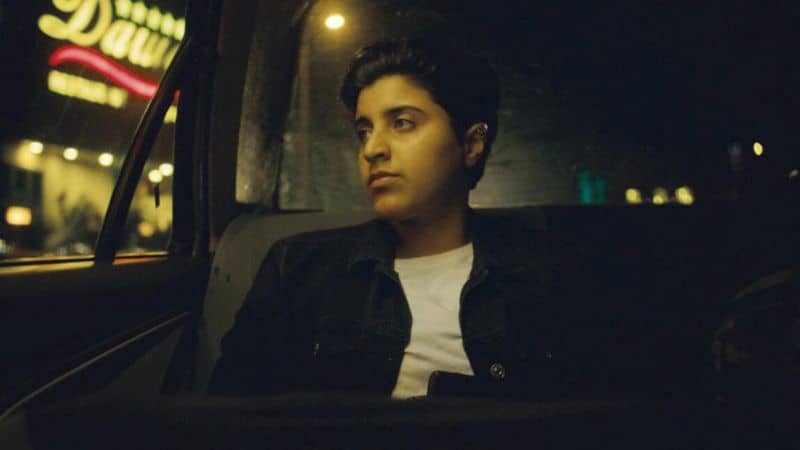Maja Tschumi’s Immortals is a visually hypnotic and emotionally charged documentary that follows three young Iraqis—two women and a man—in the aftermath of the 2019 Tahrir Square uprising in Baghdad. Blending documentary realism with dramatic re-enactment, the film creates a hybrid form where memory, danger, and imagination collide. The voiceover has a poetic quality, and combined with the greyish tableaux of Baghdad, it evokes an existential longing. These are individuals searching for connection, something lost since the brutal crackdown of the revolt at Tahrir Square in 2019. Immortals is a cinematic essay on youth, gender, trauma, and the fragile act of dreaming in a city suffocating under politics, patriarchy, and fear.

Baghdad as a living character
The backdrop is Baghdad: a city alive yet dying, teetering on the edge. In 2003, a US-led coalition invaded Iraq, establishing a sectarian political system that sparked decades of violence. By 2019, a new generation demanded its overthrow, erecting a tent city in Tahrir Square that embodied their vision for a free Iraq. This is where the film begins. The mood is festive, resembling an art movement more than a political protest. Murals call for justice, performances and cinema screenings flourish, and elders bake bread in solidarity. One mural reads, «We are the victims of an exaggerated religion,» calling for women’s rights and gender equality. Then, out of nowhere, the first gunshots from the military are heard, and this burst of creativity is violently interrupted. A demonstrator, bewildered, is shot in the neck. He stumbles around for a moment before realising he cannot breathe and collapses in front of the camera. In total, 787 were killed and over 24,000 were injured during the crackdown.
The narrative of Immortals is divided into chapters, each introducing a main character and their central struggle. Mila, a girl who escapes her domestic imprisonment by disguising herself as a boy, says, «Being part of the revolution was the highlight of my life.» Her family punishes her by burning her clothes, documents, and books, turning her identity into ashes. Walking the streets dressed as her brother, she experiences a bitter liberation shadowed by the need to perform and survive. «I hate the regime for stealing my identity,» she declares. The camera captures Baghdad in wide tableaux during the greyish-blue twilight, like a giant being forced into a sleepy state.
In 2003, a US-led coalition invaded Iraq, establishing a sectarian political system that sparked decades of violence.
Artistic vision and cinematic style
The film’s artistic qualities are exceptional. Cinematographer Silvio Gerber, editor Alex Bakri, and composer Manduk Roussyalian form a team under the direction of Maja Tschumi, whose work is so seamlessly integrated that it becomes difficult to isolate individual contributions. The camera work is not just a technical element—it becomes a character in itself. Each take is carefully composed and filled with an atmosphere reminiscent of Wim Wenders’ Paris, Texas (1984). The choice is no coincidence; later in the film, a more direct reference to Wings of Desire (1987) appears when our hero stands on a building’s ledge, overlooking a square. The next shot shows neon wings glowing behind a girl sitting on a box, forming the image of a rebellious angel. This style of poetic realism frames the film’s expression of loneliness and detachment.
Mila meets a feminist lawyer who navigates Iraq’s legal labyrinth to protect women. The film exposes the absurdity of a system where law exists but cannot protect. According to the World Bank, Iraq has one of the highest rates of sexual and domestic violence in the world, often committed within families. Even when police intervene, tribal and family pressure forces women to drop charges. Suicide becomes the only escape for many.

Confrontations and Decisions
The second chapter, Confrontations, shifts to Khalili, a young photographer. «I used to be invincible… because literally, no one noticed me,” he says. Then he discovered the camera, and photography became his language—a new way of seeing. We return to the 2019 uprising at Tahrir Square, now through Khalili’s active lens. He never shuts down his camera, not even when he is gassed and collapses, nor in the emergency room. Everything is captured: the battles, the panic, the deaths.
The protests are fleeting. The streets are deserted. Islamist influence grows stronger. Mass prayers turn public spaces into symbols of uniformity. The aftermath is haunting. Dreams are brutally suppressed, yet the youth continue to dream.
The last chapter, Decisions, examines the consequences of revolution. Khalili prepares for marriage, putting away his rebellious clothes and camera—a metaphor for the compromises of adulthood. Suddenly, he hears about the storming of Parliament on the radio and rushes out with his camera, despite his brother trying to hold him back, reminding him that he is now a married man full of responsibilities. Three years after the crackdown on Tahrir Square, one might expect Khalili to rekindle his hopeful energy, but instead, while standing in the hall among civilians waving flags, his face shows fatigue mixed with bittersweet hope. The sound design mimics drowning—distorted and dizzying—highlighting the fragile nature of victory. Voices are deformed, symbolising that systems remain deeply rooted. Hope remains fragile. For every parliamentary overturn, the government merely demonstrates its weakness, making citizens even more cautious. The real power is not in the parliament—it is still with the fathers, the husbands, and the local tribes.
Immortals is more than a documentary. It is a visual, auditory, and experiential essay. Baghdad is not just a backdrop but a living character—chaotic, scarred, resilient. The film’s mixed format echoes the challenge of capturing life under constant danger. Yet it succeeds in letting us feel the energy of its streets, the heartbeat of its youth, and their unyielding desire to dream. It is a film that does not offer closure, but something more vital: the persistence of imagination in the face of stifling repression.



